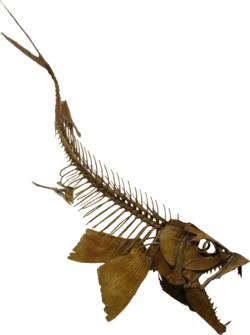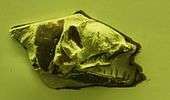Enchodus
| Enchodus Temporal range: Late Cretaceous–Eocene | |
|---|---|
 | |
| E. petrosus mounted skeleton cast in the Rocky Mountain Dinosaur Resource Center in Woodland Park, Colorado | |
| Scientific classification | |
| Kingdom: | Animalia |
| Phylum: | Chordata |
| Class: | Actinopterygii |
| Subclass: | Neopterygii |
| Order: | Salmoniformes |
| Suborder: | †Enchodontoidei |
| Family: | Enchodontidae |
| Genus: | Enchodus Agassiz, 1835 |
| Species | |
Enchodus is an extinct genus of Actinopterygii-ray-finned fish. It flourished during the Upper Cretaceous. Enchodus survived the Cretaceous–Paleogene extinction event and persisted at least into the Eocene.
Description
Enchodus species were small to medium in size. One of the genus' most notable attributes are the large "fangs" at the front of the upper and lower jaws and on the palatine bones, leading to its misleading nickname among fossil hunters and paleoichthyologists, "the saber-toothed herring". These fangs, along with a long sleek body and large eyes, suggest Enchodus was a predatory species.
The largest-known species of Enchodus is E. petrosus, remains of which are common from the Niobrara Chalk, the Mooreville Chalk Formation, the Pierre Shale, and other geological formations deposited within the Western Interior Seaway and the Mississippi Embayment. Large individuals of this species had fangs measuring over 6 centimetres (2.4 in) in length, though the total body length was only about 1.5 metres (4 ft 11 in), giving its skull an appearance somewhat reminiscent of modern deep-sea fishes, such as anglerfish and viperfish. Other species were smaller, some like E. parvus were only some cm (a few inches) long.
Despite being a formidable predator, remains of Enchodus are commonly found among the stomach contents of larger predators, including sharks, other bony fish, mosasaurs, plesiosaurs and seabirds such as Baptornis advenus.
Distribution
Enchodus species have been found all over the world. In North America, Enchodus remains have been recovered from most states with fossiliferous Late Cretaceous rocks, including Kansas, Nebraska, Colorado, Alabama, Mississippi, Georgia, Tennessee, Wyoming, Texas, California, North Carolina, and New Jersey. The taxon is also known from coeval strata in Africa, Europe, and southwest Asia.
Gallery
 Restoration of E. petrosus
Restoration of E. petrosus Enchodus lewesiensis skull
Enchodus lewesiensis skull- Teeth of Enchodus elegans from Khouribga
- Teeth of Enchodus libycus from Khouribga
References
- Cope, Edward Drinker (1874): Review of the Vertebrata of the Cretaceous period found west of the Mississippi River. U. S. Geological Survey of the Territories, Bulletin 1(2): 3-48.
- Everhart, Mike (2007): Oceans of Kansas: Enchodus sp. - The Sabre-Toothed Fish of the Cretaceous. Version of 2007-MAY-29. Retrieved 2007-AUG-23.
- Russell, D. A. (1988): A check list of North American Marine Cretaceous vertebrates including fresh water fishes. Occasional Paper of the Tyrrell Museum of Palaeontology #4.
External links
-
 Media related to Enchodus at Wikimedia Commons
Media related to Enchodus at Wikimedia Commons - Introduction to Paleontology